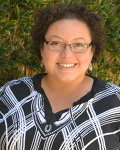Bethany Lockhart (Kindergarten Teacher):
At first glance, Everyday Math’s spiral curriculum felt daunting. One day students are finding number partners to make 10 (lesson 3-2), and the next we are building Rope Shapes (lesson 3-3). Prior to adopting Everyday Math, our curriculum had always been unit-based: for example, our K.OA.4 unit was almost three weeks long, and each day we looked at different ways to find a number that makes 10 when added to the given number. In Everyday Math, students will focus on K.OA.4 in lessons 2-9, 3-2, 4-5, 5-3, 6-11, 8-7, 8-8, etc.
So how to make sense of a spiral curriculum? I knew from the EdReports’ review on Everyday Math that there was a gap in the coherence of the lessons. How do we increase coherence and build toward the Major Work of the Grade? How do you make it cohesive for yourself as a teacher and for your students? Our Kindergarten team reached out to Jody Guarino, a Mathematics Coordinator at the Orange County Department of Education, to get her perspective on diving into a spiral curriculum.
Jody Guarino (Mathematics Coordinator):
Hearing Bethany and other teachers trying to make sense of how to think about and work with a spiral curriculum, I wondered what kind of support would be helpful. First, how do we make sense of a curriculum that spirals? In the case of Everyday Math, concepts are taught within clusters of lessons and spread out over time. Several of these clusters then make up a unit.
We began to unpack the design of the program within the context of an upcoming unit: Section Three. The Spiral Trace at the beginning of the section outlined some of the concepts within the section as well as how those concepts were progressing toward mastery. We then thought about how the concepts in Section Three build upon the concepts in Section Two. Counting and cardinality had a big presence in both sections, with students moving along the trajectory.
Our next stopping point was Mathematical Background. As we dove into this section, we unpacked the three themes within the chapter: Reading and Writing Numbers, Making Comparisons, and Counting and Cardinality. As we read each subsection, we considered a few guiding questions: What are the critical ideas of each section? What is the progression of ideas within the section? How can we maintain coherence? These questions seemed critical in understanding both the architecture of the program and connections within and between lessons.
Moving to the grain size of a lesson and keeping in mind the three themes within the chapter, we looked at the lesson from a new perspective. How does this lesson build from the prior lesson? How is it building to the next lesson? How does it connect to one or more of the themes within the section? This was a new way of thinking and we saw things in lessons we hadn’t seen before. Where we had previously questioned the sequence from counting activities to building shapes, we now understand the through-line…each of these activities builds the concept of comparison. This new way of thinking leads to deeper learning for us, as we see connections we haven’t previously seen, and for our students, as we’re now thinking about how we can make those connections explicit for them.
Bethany Lockhart (Kindergarten Teacher):
This process felt so liberating! As a teacher, it is easy to jump to the lessons for the week without stepping back and getting the big picture of the chapter first. In my haste, I had skimmed the spiral trace and the mathematical background. Yes, they provided useful information, but I hadn’t used them to uncover the thread and through-line that would weave through the whole chapter and the program as a whole. Once I had that big picture, it enabled me to support my students in making connections. While comparing representations of “5” in lesson 3-7, I could use the comparison language we used in the making rope shapes lesson (3-3), and then again in 3-10 when students matched sets to numerals. If you weren’t thinking about the through-line of comparison you might take just a chunk of the lesson or not spend time on the comparison aspect of the task. In lesson 3-1, students count and compare the number of shapes in their pattern-block graph and in 3-13, students count and compare numbers as they reference quick-look images. The thread was there; I just needed to step back to find it.
At the end of the unit, my students have covered a variety of ways to compare numbers, shapes, and sets, and most of all we have built upon the idea that math really does look all sorts of ways. I treat our lessons as adventures and a chance to explore. We celebrate connections students can find in our previous work and find ways to keep building on the knowledge they have gained in previous units. It all spirals back again, next time adding a new layer, a new perspective, and hopefully a new depth of understanding.



















